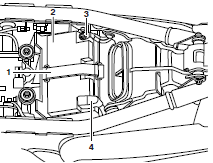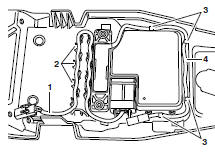 Triumph Scrambler 1200 XE - Owner's Manual > Battery
Triumph Scrambler 1200 XE - Owner's Manual > Battery
Warning
Under some circumstances, the battery can give off explosive gases; keep sparks, flames and cigarettes away. Provide adequate ventilation when charging or using the battery in an enclosed space.
The battery contains sulphuric acid (battery acid). Contact with skin or eyes may cause severe burns. Wear protective clothing and a face shield.
If battery acid gets on your skin, flush with water immediately.
If battery acid gets in your eyes, flush with water for at least 15 minutes and SEEK MEDICAL ATTENTION IMMEDIATELY.
If battery acid is swallowed, drink large quantities of water and SEEK MEDICAL ATTENTION IMMEDIATELY.
KEEP BATTERY ACID OUT OF THE REACH OF CHILDREN.
Warning
The battery contains harmful materials. Always keep children away from the battery whether or not it is fitted in the motorcycle.
Do not attach jump leads to the battery, touch the battery cables together or reverse the polarity of the cables as any of these actions may cause a spark which would ignite battery gases causing a risk of personal injury.
Battery Removal
Warning
Make sure that the battery terminals do not touch the motorcycle frame.
This may cause a short circuit or spark which would ignite battery gases causing a risk of personal injury.
To remove the battery:
- Remove the seat
- Release the three fixings and carefully detach the storage tray.

- Front fixings
- Storage tray
- Rear fixing
Note
Take note of the positioning and routing of the USB connector and the Low Frequency (LF) antenna cables for reinstalling.
- Carefully turn over the storage tray and detach the USB connector and the Low Frequency (LF) antenna cables from the storage tray.

- USB connector cable
- USB connector cable retaining clips
- Low Frequency (LF) antenna cable retaining clips
- Low Frequency (LF) antenna cable
- Position the storage tray to allow access to the battery.

- Battery strap
- Battery
- Negative (-) terminal
- Positive (+) terminal
- Disconnect the battery leads, negative (black) lead first.
- Remove the battery strap.
- Take the battery out of the case.
Battery Disposal
Should the battery ever require replacement, the original battery must be handed to a recycling agent who will make sure that the dangerous substances from which the battery is manufactured do not pollute the environment.
Battery Maintenance
Warning
Battery acid is corrosive and poisonous and will cause damage to unprotected skin. Never swallow battery acid or allow it to come into contact with the skin. To prevent injury, always wear eye and skin protection when handling the battery.
Clean the battery using a clean, dry cloth. Make sure that the cable connections are clean.
The battery is a sealed type and does not require any maintenance other than checking the voltage and routine recharging when required, such as during storage (see the following paragraphs).
It is not possible to adjust the battery acid level in the battery; the sealing strip must not be removed.
Battery Discharge
Caution
The charge level in the battery must be maintained to maximise battery life.
Failure to maintain the battery charge level could cause serious internal damage to the battery.
Under normal conditions, the motorcycle charging system will keep the battery fully charged. However, if the motorcycle is unused, the battery will gradually discharge due to a normal process called self discharge; the clock, Engine Control Module (ECM) memory, high ambient temperatures, or the addition of electrical security systems or other electrical accessories will all increase this rate of battery discharge.
Disconnecting the battery from the motorcycle during storage will reduce the rate of discharge.
Battery Discharge During Storage and Infrequent Use of the Motorcycle
During storage or infrequent use of the motorcycle, inspect the battery voltage weekly using a digital multimeter.
Follow the manufacturer's instructions supplied with the meter.
Should the battery voltage fall below 12.7 Volts, the battery should be charged.
Allowing a battery to discharge or leaving it discharged for even a short period of time causes sulphation of the lead plates. Sulphation is a normal part of the chemical reaction inside the battery, however over time the sulphate can crystallise on the plates making recovery difficult or impossible.
This permanent damage is not covered by the motorcycle warranty, as it is not due to a manufacturing defect.
Keeping the battery fully charged reduces the likelihood of it freezing in cold conditions. Allowing a battery to freeze will cause serious internal damage to the battery.
Battery Charging
Warning
The battery gives off explosive gases; keep sparks, flames and cigarettes away. Provide adequate ventilation when charging or using the battery in an enclosed space.
The battery contains sulphuric acid (battery acid). Contact with skin or eyes may cause severe burns. Wear protective clothing and a face shield.
If battery acid gets on your skin, flush with water immediately.
If battery acid gets in your eyes, flush with water for at least 15 minutes and SEEK MEDICAL ATTENTION IMMEDIATELY.
If battery acid is swallowed, drink large quantities of water and SEEK MEDICAL ATTENTION IMMEDIATELY.
KEEP BATTERY ACID OUT OF THE REACH OF CHILDREN.
Caution
Do not use an automotive quick charger as it may overcharge and damage the battery.
For help with selecting a battery charger, checking the battery voltage or battery charging, contact your local authorised Triumph dealer.
Should the battery voltage fall below 12.7 Volts, the battery should be charged using a Triumph approved battery charger. Always remove the battery from the motorcycle and follow the instructions supplied with the battery charger.
For extended periods of storage (beyond two weeks) the battery should be removed from the motorcycle and kept charged using a Triumph approved maintenance charger.
Similarly, should the battery charge fall to a level where it will not start the motorcycle, remove the battery from the motorcycle before charging.
Battery Installation
Warning
Make sure that the battery terminals do not touch the motorcycle frame.
This may cause a short circuit or spark which would ignite battery gases causing a risk of personal injury.
To install the battery:
- Place the battery in the battery case.
- Secure with the battery strap.
- Reconnect the battery, positive (red) lead first.
- Tighten the battery terminals to 4.5 Nm.
- Apply a light coat of grease to the terminals to prevent corrosion.
- Cover the positive terminal with the protective cap.
- Reattach the USB connector and the Low Frequency (LF) antenna cables to the storage tray as noted for removal.

- USB connector cable
- USB connector cable retaining clips
- Low Frequency (LF) antenna cable retaining clips
- Low Frequency (LF) antenna cable
- Refit the storage tray and tighten the two front fixings to 5 Nm and the rear fixing to 3 Nm.

- Front fixings
- Storage tray
- Rear fixing
- Refit the seat
See also:
 Triumph Scrambler 1200 XE - Owner's Manual > Tyres
Triumph Scrambler 1200 XE - Owner's Manual > Tyres
This motorcycle is equipped with tubeless tyres, valves and spoked wheels. Warning Inner tubes must only be used on motorcycles fitted with spoked wheels and with tyres marked 'TUBE TYPE'.
 Triumph Scrambler 1200 XE - Owner's Manual > Fuses
Triumph Scrambler 1200 XE - Owner's Manual > Fuses
Warning Always replace blown fuses with new ones of the correct rating (as specified on the fuse box cover) and never use a fuse of higher rating. Use of an incorrect fuse could lead to an electrical problem, resulting in motorcycle damage, loss of motorcycle control and an accident.
 Ducati Scrambler
Ducati Scrambler Fantic Caballero 500
Fantic Caballero 500 Indian FTR 1200
Indian FTR 1200 Moto Guzzi V85 TT
Moto Guzzi V85 TT Royal Enfield Bullet Trials Works Replica
Royal Enfield Bullet Trials Works Replica Triumph Scrambler 1200 XE
Triumph Scrambler 1200 XE Triumph Street Scrambler
Triumph Street Scrambler Yamaha XSR700
Yamaha XSR700 Ducati Scrambler 800
Ducati Scrambler 800 Moto Guzzi V85 TT
Moto Guzzi V85 TT Triumph Scrambler 1200 XC
Triumph Scrambler 1200 XC